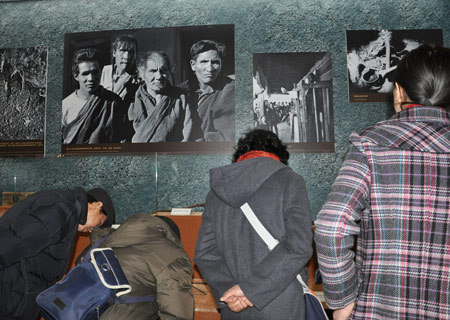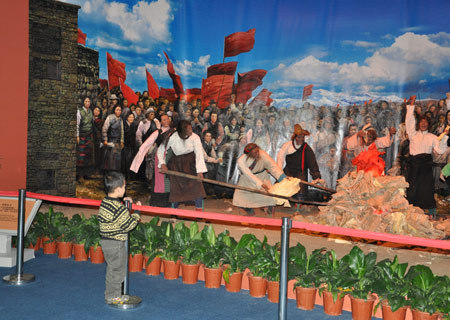For many people, 1959 is just a number, or perhaps a date in a textbook. But for those who witnessed events in Tibet that year, it remains an indelible memory after half a century.
Gyaga Losang Tangyai, now 81, remains forceful and energetic. In 1959, he was serving under the 10th Panchen Lama, who was the second most important religious figure next to the Dalai Lama.
The Panchen Lama controlled many temples and much land in old Tibet, just like other living Buddhas.
In 1954, Gyaga accompanied the Panchen Lama and 14th Dalai Lama on a mission to Beijing on behalf of the Gaxag government (the old Tibetan government). They were received by the late Chairman Mao Zedong.
"He told us that democratic reform wouldn't be carried out for at least six more years," Gyaga recalled.
"Democratic reform" literally meant the end of serfdom and abolition of the hierarchic social system characterized by a theocracy, with the Dalai Lama as the core of the leadership. That system had existed in Tibet for some 1,000 years.
 |
|
Visitors look at objects that were used by serf owners to torture serfs in old Tibet at an exhibition marking the 50th anniversary of the Democratic Reform in Tibet Autonomous Region in Beijing, Feb. 25, 2009. (Xinhuanet Photo)
|
The aim was to free about 1 million serfs and slaves who accounted for 90 percent of the Tibetan population in the 1950s. They were controlled by lamas, officials and nobles, including the Dalai Lama's family.
Mao believed that reform, despite public appeal, could only be launched when the Tibetan nobles, including the Dalai Lama, were ready to support it. Without that support, reform would have to be further postponed, Mao told the Tibetan delegation. With that understanding, they returned home.
SURPRISE IN 1959
One day five years later, Gyaga was taken by surprise at the Tashilunpo Temple in Xigaze. He was told that the Dalai Lama and his supporters had staged an "armed riot" in Lhasa, which was then-- as now -- the capital of Tibet.
"I got the news from soldiers, and the Panchen Lama soon asked me to accompany him to Beijing by way of Lhasa," he said.
They arrived in Lhasa on March 20, 1959. The city had become a totally unfamiliar place to Gyaga.
"It looked like a war zone: few people outside, craters in the streets."
He and the Panchen Lama first visited the Jokhang Temple, where lamas "appeared disoriented ... There was water everywhere, and they told us that they had just put out a fire."
The situation was even worse at the Ramoche Temple, also in Lhasa, where they saw no lamas, only "bullet holes on the golden roof," he said.
"I felt that the rebels had gone mad," he said. "How can they damage their own city?" He gestured furiously while recounting the long-ago story.
 |
|
A boy watches a simulated scenario featuring serfs burning feudal documents produced in old Tibet after the Democratic Reform at an exhibition marking the 50th anniversary of the Democratic Reform in Tibet Autonomous Region in Beijing, Feb. 25, 2009. (Xinhuanet Photo)
|
FATEFUL DAY
Ngapoi Ngawang Jigme, son of a Tibetan aristocrat who later became vice chairman of the 11th National Committee of the Chinese People's Political Consultative Conference (CPPCC, the top advisory body), also recalls the riot in 1959. His account goes like this:
The Dalai Lama wanted to watch a troupe of the Tibet Military Region on March 10, but he declined to have them come to Norbu Lingka, his palace. Instead, he insisted on going to a military auditorium, where he said his supporters would meet him.
"I sensed that something would happen," because the Dalai Lama rarely left Norbu Lingka, recalled Ngapoi, now 98.
On the morning of March 10, 1959, he said, turmoil broke out in Lhasa. People were fearful that the Dalai Lama had been kidnapped.
"Some people cried out, 'let us protect our treasure! The Hans kidnapped him!' The Hans are the ethnic Chinese majority.
"This was like a bolt from the blue to pious Tibetans, who soon flooded to Norbu Lingka in shock, confusion and horror ..."
But, Ngapoi said, the rumor was spread by the Dalai Lama's supporters. Rioters soon surrounded Norbu Lingka, intent on killing and destruction, shouting "Tibet independence" and "get out, you Hans".